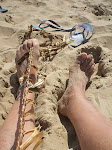
Sellers need to enjoy watching the sun rise. Pitches are established on a first come basis before dawn and, if you are an amateur, it is necessary to be awake enough to haggle with the professionals who scan the contents of your car with their torches as you wait for it to get light enough to set up stall. If not, you discover when you do finally wake up that the things they bought from you in your early morning stupor are now on their stalls at twice the price.
Keen collectors also arrive early but those who go for the spectacle, and barquettes of freshly cooked frites or a glass of wine for 50c (unheard of in a bar) arrive at lunchtime, when eating has become the priority for sellers and buyers alike. The picnic tables are laid, the camping chairs clacked open, corks popped and Sunday lunch is enjoyed surrounded by many of the same possessions that previously graced the diner’s homes. These are now no longer wanted, liked or needed and sit sulkily on the grass hoping to attract new and kinder owners. If you find something you want to buy at this time of day you are far more likely to get a good price simply because you are taking up valuable eating time.
Visually raking over the tables laden with the physical manifestations of consumerism, I try to understand this foreign semiotic language. What could possibly have made someone want to buy a coat rack made out of the bent feet of goats nailed to a wooden board! And why does no one want to keep these lovely coiled straw baskets that are the tradition of this region and which embody so much of the history of rural existence here as it was only 70 years ago? What do either of these observations tell me about the people who once owned these objects?
That these Poitou Charente baskets employ the same materials and techniques as those of the Shetland tradition seems too coincidental for me to ignore and the temptation to become a rescue centre for these filthy, abused and neglected baskets has overwhelmed me. Invariably, after failing to persuade myself that I do not need another basket, I part with a few euros, (I don’t usually haggle as knowing the hours of labour that went into their making they are, for me, too cheap already). As the coins slip into the sellers pocket, I am aware of the burden of responsibility I am taking on. Now, I will have to find some way of dealing with this rapidly increasing collection of large baskets that will give these humble objects back some of their simple beauty and dignity.
 |
| Click here to see more baskets |









